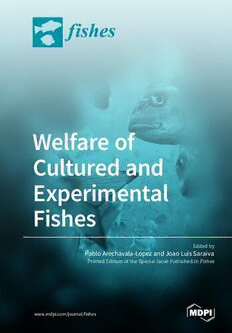
Welfare of Cultured and Experimental Fishes PDF
Preview Welfare of Cultured and Experimental Fishes
Welfare of Cultured and Experimental Fishes Edited by Pablo Arechavala-Lopez and Joao Luis Saraiva Printed Edition of the Special Issue Published in Fishes www.mdpi.com/journal/fishes Welfare of Cultured and Experimental Fishes Welfare of Cultured and Experimental Fishes SpecialIssueEditors PabloArechavala-Lopez JoaoLuisSaraiva MDPI•Basel•Beijing•Wuhan•Barcelona•Belgrade SpecialIssueEditors PabloArechavala-Lopez JoaoLuisSaraiva CentrodeCieˆnciasdoMar CentrodeCieˆnciasdoMar (CCMAR) (CCMAR) Portugal Portugal EditorialOffice MDPI St.Alban-Anlage66 4052Basel,Switzerland ThisisareprintofarticlesfromtheSpecialIssuepublishedonlineintheopenaccessjournalFishes (ISSN2410-3888)from2018to2019(availableat: https://www.mdpi.com/journal/fishes/special issues/FishWelfare). Forcitationpurposes,citeeacharticleindependentlyasindicatedonthearticlepageonlineandas indicatedbelow: LastName,A.A.; LastName,B.B.; LastName,C.C.ArticleTitle. JournalNameYear,ArticleNumber, PageRange. ISBN978-3-03921-710-6(Pbk) ISBN978-3-03921-711-3(PDF) ImagecourtesyofPabloArechavala-Lopez. (cid:2)c 2019bytheauthors. ArticlesinthisbookareOpenAccessanddistributedundertheCreative Commons Attribution (CC BY) license, which allows users to download, copy and build upon publishedarticles,aslongastheauthorandpublisherareproperlycredited,whichensuresmaximum disseminationandawiderimpactofourpublications. ThebookasawholeisdistributedbyMDPIunderthetermsandconditionsoftheCreativeCommons licenseCCBY-NC-ND. Contents AbouttheSpecialIssueEditors . . . . . . . . . . . . . . . . . . . . . . . . . . . . . . . . . . . . . vii Joa˜oL.SaraivaandPabloArechavala-Lopez WelfareofFish—NoLongertheElephantintheRoom Reprintedfrom:Fishes2019,4,39,doi:10.3390/fishes4030039 . . . . . . . . . . . . . . . . . . . . . 1 CristinaBarraga´n-Me´ndez,FiniSa´nchez-Garc´ıa,IgnacioSobrino,JuanMiguelManceraand IgnacioRuiz-Jarabo Air Exposure in Catshark (Scyliorhinus canicula) Modify Muscle Texture Properties: A PilotStudy Reprintedfrom:Fishes2018,3,34,doi:10.3390/fishes3030034 . . . . . . . . . . . . . . . . . . . . . 4 SebastianM.Strauch,JudithBahr,Bjo¨rnBaßmann,AdrianA.Bischoff,MichaelOster,Berit WasenitzandHarryW.Palm EffectsofOrtho-PhosphateonGrowthPerformance,WelfareandProductQualityofJuvenile AfricanCatfish(Clariasgariepinus) Reprintedfrom:Fishes2019,4,3,doi:10.3390/fishes4010003. . . . . . . . . . . . . . . . . . . . . . 15 Ma´rcioMoreira,Ana´ısaCordeiro-Silva,MarisaBarata,PedroPousa˜o-FerreiraandFlorbela Soares InfluenceofAgeonStressResponsesofWhiteSeabreamtoAmyloodiniosis Reprintedfrom:Fishes2019,4,26,doi:10.3390/fishes4020026 . . . . . . . . . . . . . . . . . . . . . 32 MelanieA.Woodward,LucyA.WinderandPenelopeJ.Watt EnrichmentIncreasesAggressioninZebrafish Reprintedfrom:Fishes2019,4,22,doi:10.3390/fishes4010022 . . . . . . . . . . . . . . . . . . . . . 47 AnthonyG.Deakin, JosephW.Spencer, AndrewR.Cossins, IainS.YoungandLynneU. Sneddon Welfare Challenges Influence the Complexity of Movement: Fractal Analysis of Behaviour inZebrafish Reprintedfrom:Fishes2019,4,8,doi:10.3390/fishes4010008. . . . . . . . . . . . . . . . . . . . . . 60 Eliane Gonc¸alves-de-Freitas, Marcela Cesar Bolognesi, Ana Carolina dos Santos Gauy, ManuelaLombardiBranda˜o,PerciliaCardosoGiaquintoandMarisaFernandes-Castilho SocialBehaviorandWelfareinNileTilapia Reprintedfrom:Fishes2019,4,23,doi:10.3390/fishes4020023 . . . . . . . . . . . . . . . . . . . . . 76 IsabelFife-CookandBeccaFranks PositiveWelfareforFishes:RationaleandAreasforFutureStudy Reprintedfrom:Fishes2019,4,31,doi:10.3390/fishes4020031 . . . . . . . . . . . . . . . . . . . . . 90 Joa˜o Luis Saraiva, Pablo Arechavala-Lopez, Maria Filipa Castanheira, Jenny Volstorf and BilloHeinzpeterStuder AGlobalAssessmentofWelfareinFarmedFishes:TheFishEthoBase Reprintedfrom:Fishes2019,4,30,doi:10.3390/fishes4020030 . . . . . . . . . . . . . . . . . . . . . 104 v About the Special Issue Editors Pablo Arechavala-Lopez (PhD). Pablo Arechavala-Lopez has a solid background in marine ecology, ichthyology, andcoastalaquaculture. Hisresearchismainlyfocusedonthestudyofthe behaviorofculturedfish, aswellasonthemanagementofcoastalareas, evaluatingtheinfluence of aquaculture activities on wild fish populations and coastal ecosystems. More recently, he has beenapplyinghisknowledgeandexperiencetothefieldoffishwelfareinaquaculture,analyzing thephysiologicalandbehavioraladaptationsoffishtorearedandenrichedenvironmentsandalso actingasaconsultantonfishwelfareforworldwideaquaculturecompanies. JoaoL.Saraiva(PhD).JoaoL.Saraivaisafishethologistwithaspecialinterestinwelfare. He is currently leading the Fish Ethology and Welfare Group at CCMAR and is the president of the FishEthoGroupAssociation. Withacareerbuiltontheinterplaybetweenproximateandultimate mechanismsunderlyingsocialbehaviorandcommunicationinteleosts,Dr. Saraivaisnowfocusing ontheapplicationoffundamentalsciencetoimprovethewelfareoffarmedfish. Alongwithhis scientificactivity,Dr. SaraivaisalsopartoftheteamofFishEthoBase,anopen-accessdatabaseon welfareoffarmedfishspecies. vii fishes Editorial Welfare of Fish—No Longer the Elephant in the Room JoãoL.Saraiva1,* andPabloArechavala-Lopez1,2 1 FishEthologyandWelfareGroup,CCMAR,8000-536Faro,Portugal 2 FishEcologyGroup,IMEDEA(CSIC/UIB),07190Esporles,IllesBalears,Spain * Correspondence:joao@fair-fish.net (cid:2)(cid:3)(cid:4)(cid:2)(cid:5)(cid:6)(cid:7)(cid:8)(cid:9) Received:27June2019;Accepted:28June2019;Published:3July2019 (cid:2)(cid:3)(cid:4)(cid:5)(cid:6)(cid:7)(cid:8) Theconceptoffishwelfareisfairlyrecentandwasoverlookedformanyyears,basedonapopular misconceptionthatfishwere“stupid”creaturesdevoidofanykindofsentienceormentalcapability. However,agrowingbodyofresearchonfishbehaviour,cognition,learningandneurosciencemade clearthatthisisevidentlynotthecase—fishareindeedsociallycomplex[1],havedevelopedcognitive andlearningabilitieswiththeneuralsubstratetosupportthem[2,3]andaresentient[4]. Asthe evidenceforfishmentalcompetencesgrewlarger,theuncomfortablequestionsregardingthewelfare stateoffishandtheethicalimplicationsoffishfarmingbecameanelephantintheroomthatnobody wouldaddress. However, therearerecentindicationsthatthingsarechanging, andthepresent collectionofexcellentcontributionssuggeststhatalltheinterestedparties(scientists,farmers,retailers, NGOsandconsumers)arenowdirectlyapproachingthesubject.Ladiesandgentlemen,theelephant hasleftthebuilding. In fact, these papers are a fantastic example of the many perspectives that may be used whentacklingfishwelfare. Inapilotstudyregardingfisheriesofcatshark(Scyliorhinuscanicular), Barragán-Méndezetal.[5]demonstratethatthestandardpracticesofexposingthewild-caughtanimals toairarenotonlyextremelyharmfulforthefishbutalsomodifymuscletexturepropertiesandreduce thequalityofthemeat.Thisstudydemonstratestheurgencyofimprovingthewelfareofwild-caught fishandindicatestheroadaheadregardingtheassessmentofhumanepracticesinfisheries. The paperbyStrauchetal.[6]alsohighlightshowacommonpracticeofaddingphosphatetointegrated aquaponicsystemsasafertilizercanhavenegativeeffectsinAfricancatfish(Clariasgariepinus),not onlyontheirwelfarebutalsoonthemeatquality. Thesetwostudiesemphasizeacorrelationthat shouldbeclearforthefishindustry:whenthewelfareofanimalsisimproved,boththequalityofthe productanditsvalueincrease—ararecasewhentheinterestoftheindustryandtheethicalstandards underlyingitsactivitywalkhandinhand. ThestudybyMoreiraetal.[7]takesanontogenicapproachintoamyloodiniosis,awell-known healthprobleminwhiteseabream(Diplodussargus)farmedinSouthernEurope.Focusingonfishhealth isnotnewinwelfareresearch.Afterall,healthisoneofthekeycomponentsforconceptualframework ofwelfare,togetherwiththementalandnaturalcomponents.Thenoveltyofthispaperistosearchfor anon-veterinaryapproachtodealwithahealthissue,usingoneofTinbergen’sFourQuestionsthat issooftenoverlooked: development. Theresultsshowthatyoungfisharefarmoresusceptibleto infectionbyAmyloodiniumocellatumbecausetheylackimmuneandphysiologicalresponsesthatonly appearlaterinontogeny.Thisstudyhighlightstheneedtotakeintoaccounttheageoftheindividuals whendesigningpreventionandtreatmentplansaswellasrearingroutines. Zebrafishwelfarewasanothersurprisinglyignoredissueuntilrecenttimes. Thenumberof culturedindividualsarguablyrivalsanyothercommerciallyfarmedspecies,yetevenwhenthesubject ofwelfareinaquaculturestartedtobeaddressed,zebrafishwereapparentlyleftbehind. Sayno morebecausetwostudiesbyWoodwardetal.[8]andDeakinetal.[9]focusontwoimportanttopics thatimpactzebrafishwelfare: thefirstshowsthatenvironmentalenrichmentinzebrafishhousing promotesaggressionandrisk-takingbehavioursinzebrafish[8],andtheauthorsexplainthiswiththe Fishes2019,4,39;doi:10.3390/fishes4030039 1 www.mdpi.com/journal/fishes
